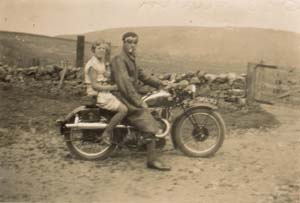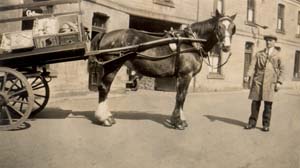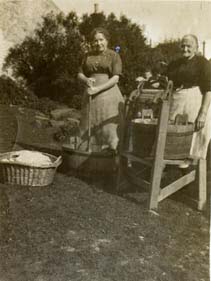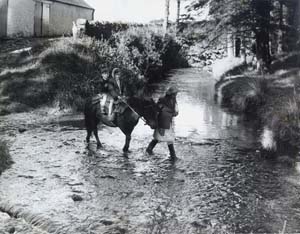|

|
|
Below are some examples from the Museums
Picture Collection. Please click for the bigger picture.
|
|



|

|
Stumpy road, Crawfordjohn, about 1910
Four roads lead into Crawfordjohn village, and each had its local name that did not appear on any map. There was the “Gateside road”, from Douglas Moor, the “mill road”, from Abington, and the “pyotshaw (magpie) road” from Leadhills. This is the “stumpy road”, from Sanquhar, so called because of a tree stump, now long gone, beside the road.
Miss Marchbanks and a friend are walking towards the village from her father’s joiner’s shop at The Burn, seen in the background.
|
|
|

|
Bob Allan and Jean Alexander at Liscleugh Farm, 1938.
The coming of motor transport in the 20th century changed patterns of life on the hill farms that had probably altered little in centuries. For a ploughman like Bob Allan, working on an isolated farm two miles from Crawfordjohn village itself, his second-hand BSA motorcycle gave him freedom to travel that would have been unheard of only a generation before.
Jean Alexander was the niece of the man who farmed Liscleugh. After she married Bob Allan, the couple went to live at Strathaven.
|
|
|

|
An Upland Shepherd, 1950-1955
Jimmy McKay was shepherd at Gilkerscleugh Mains Farm, Crawfordjohn in the 1950s. The picture shows him with part of his flock of Blackfaced sheep (generally known as “Blackies”), against the treeless, upland landscape. From the size of their horns, these are “hoggs” - last year’s lambs, which are counted as one year old from 1st January, regardless of when they were actually born. They are in full fleece, which suggests the picture was taken in April or May, before “hogg clipping”, which takes place in June.
Neighbours shared the work during “the clippings”, all helping each other in turn. It was a highly social occasion and provided an opportunity for the farmers to view each other’s livestock.
|
|
|

|
Mr Bain, travelling greengrocer, Douglas, 1930s
Shopping was not easy in the Southern Uplands. Crawfordjohn’s nearest towns, Lanark, Biggar and Sanquhar, were all at least two hours away by horse and would only be visited for major purchases, such as clothes or furniture. From the mid 19th century, Abington developed as a local centre with a bakery and other shops, and Crawfordjohn village had one shop that sold some of the basics. Much shopping would be done off vans and carts that visited the community.
Mr Bain had a shop in Douglas, but also took his horse-drawn flat cart around the farms and smaller villages. In the year 2000, Bain’s van still came once a week to Crawfordjohn.
|
|
|

|
Washday in Crawfordjohn village in the 1920s.
In the days before washing machines and biological detergents, washing the clothes and linen for a large family was a major operation, taking perhaps a whole day. Crawfordjohn village did not get mains water until the 1940s, and water had to be carried from the communal “fountain” and then heated in a coal-fired wash boiler.
This snapshot, taken during the 1920s, shows Mrs Miller and her friend standing beside washtubs and wringer, in the open air.
|
|
|

|
Off to school, Glendorch, Crawfordjohn, August 1954
As late as the 1950s some hill farming families faced real extremes of rural isolation. Glendorch, the “dark glen”, in the hills between Crawfordjohn and Leadhills, and two miles from the nearest road, is the site of a medieval “bastle house”, or fortified farmstead. Its last
occupants were a shepherd who worked for the Earl of Hopetouns estate, and his family, who lived in a cottage near the ruined bastle house. The only way that Anne Thompson, aged 8, and her brother Sandy, aged 5, could get to school in Crawfordjohn village was on Mary the farm pony.
The photograph was taken by the “Daily Express”, which ran a news story on the challenge that faced this family in getting the children to school.
|
|
|